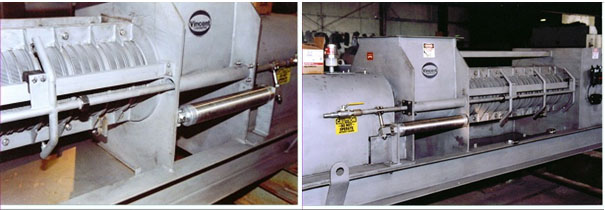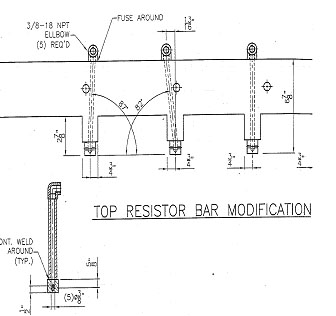Sometimes screw presses are used to squeeze material destined for human consumption. Typically this is a fruit or berry juice, nutraceuticals, or pharmaceuticals. Sanitation requirements lead to discussion of CIP, Clean In Place. There are two CIP’s to consider: internal and external.
EXTERNAL
Two attached photos show an external CIP system for spraying the outside of the screens. The nozzles have a fan-shaped spray pattern, and the air cylinder moves the spray rings back and forth the length of the screen. There are multiple spray rings on each manifold; that way a shorter air cylinder can be used and still get full coverage. There is an air cylinder, manifold, and spray rings assembly required on each side of the press. From Vincent’s standpoint, the trickiest part of the design is making it so that the piping can all be removed easily: we do not want piping to interfere with removal of the screen.
An alternate is to have nozzles in fixed manifolds. These nozzles use a cone-shaped spray pattern. We put in four manifolds, each running from one end of the screen to the other. There is one at the top on each side of the screen, and one at the bottom on each side of the screen. The cleaning is not as effective as it is with the air cylinder actuator. An attached photo shows a lower spray manifold, with cone-pattern nozzles directed up towards the screen.
Sometimes Vincent supplies a pressure booster pump to get the pressure of the spray water up to about 200 psi. The kit includes a solenoid operated water valve, a water filter, and a timer panel. The timer panel has a clock to set the frequency of spraying cycles, another clock to set the duration of the spray cycle, contacts to turn on the pump starter and open the solenoid water valve, and, if necessary, a four-way air valve to run the air cylinders back and forth.
Alternatively, the operators can take off the screen covers and pressure wash everything by hand.
INTERNAL
For internal CIP most food plants unbolt the screens and swab the screw and screen with caustic solution. We can facilitate this by hinging the screens so that they swing open.
Alternatively, we can drill the top resistor teeth so that steam, caustic solution, or high pressure water can be injected into the press. This is done with the press in operation, empty but with the screw turning. A block with a cross hole is welded to the end of each tooth so that the cleaning fluid shoots upstream and downstream. This is illustrated in the attached sketch.

EXTERNAL CIP: AIR CYLINDER MOVES SPRAY MANIFOLD WITH SPRAY RINGS

EXTERNAL: NOTE SPRAY AT BOTTOM INTERNAL: THROUGH RESISTOR TEETH

DRILLING RESISTOR TEETH FOR INTERNAL CIP
Issue 233
